Distinguished Critique: Wonder Woman by George Perez (vol. 2) Review
This second volume unveils the compelling further adventures of a hero who represents the bridge between humanity and myth
—by Nathan on July 27, 2025—
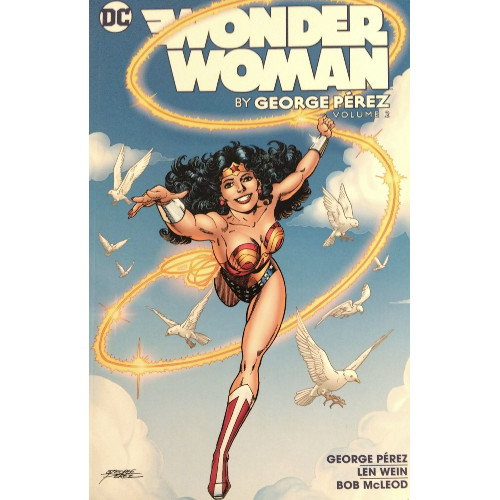
Early last year, I reviewed the first volume collecting a portion of George Perez's celebrated run on Wonder Woman, fourteen issues which introduced Princess Diana of Themyscira to the then-modern world of DC's post-Crisis landscape…and, just as importantly, introduced the then-modern world to Wonder Woman.
As I've delved a tad deeper into post-Crisis reimaginings of characters such as Batman, Green Lantern, Superman, Green Arrow, and members of the Suicide Squad, I've decided to do the same with the publisher's famous Amazonian Princess. As in the first volume, Perez receives some help from Swamp Thing and Wolverine co-creator Len Wein, but it's in this collection where Perez's voice makes itself heard, as he fully takes over writing duties as well as artistic responsibilities in shaping Wonder Woman's worlds.
And that word "worlds" is accurate, as we will explore Diana's impact on human society as well as her beloved home of Themyscira and even the fabled realm of Olympus, home of the legendary pantheon to which Diana owes her very existence.
Wonder Woman by George Perez (vol. 2)
Writers: George Perez, Len Wein
Pencilers: George Perez, Brian Bolland, Chris Marrinan, Art Adams, John Bolton, José Luis Garcia-López, Curt Swan, and Ross Andru
Inkers: Bob McLeod, Dick Giordano, Will Blyberg, Bruce Patterson, Bob Smith, Frank McLaughlin, Mark Farmer, Ar Adams, John Bolton, Jose Luis Garcia-Lopez, and George Perez
Colorists: Carl Gafford
Letterers: John Costanza and Todd Klein
Issues: Wonder Woman #15-24, Wonder Woman Annual #1
Publication Dates: April 1988-December 1988
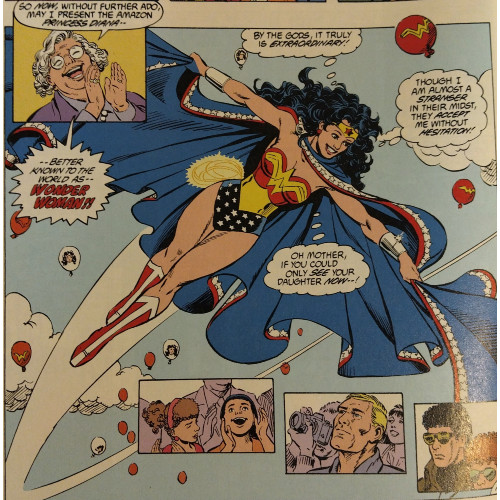
In my review of the first volume, I gushed about how well Perez brought myth into the modern realm, how Wonder Woman was an idiosyncratic blend of Greek legend and real world drama. The god Ares attempts to ignite nuclear war! Wonder Woman rescues Steve Trevor, a downed US airman whose plane crashes near Themyscira. Even Diana''s origin, it's revealed late in the volume, has surprising Western connections which help forge the bond between her and Steve. The mythological aspects never seem out of place, melded well with the late 80s real world Diana stumbles into and where she increasingly finds herself comfortable.
That cocktail recipe of modernity and myth is doubled down upon during this volume, and if you thought Perez handled the material well in the first collection, he ratchets the tension and importance of those ideas in these issues. Len Wein helps craft the first few stories presented in this volume, but Perez takes complete control partway through, and under his guidance, the storytelling and themes are made more apparent and important to the overarching narrative told. There are several smaller stories within this volume, yes, but each hinge upon Diana serving as a bridge between a very real, conflicted, sometimes suspicious society and a realm which has long been relegated to mythic status, showing its power and glory to people who find their lives upended as mankind and godkind collide.
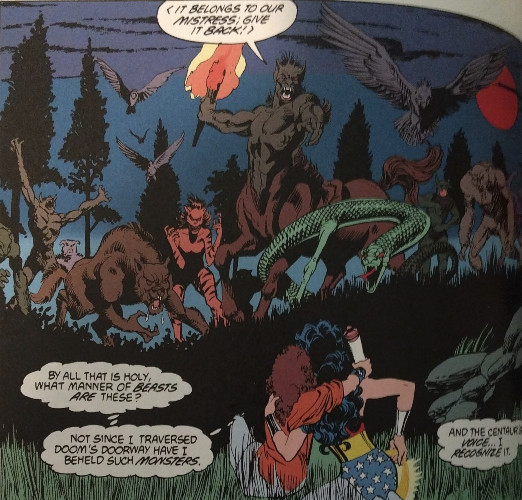
The first volume presented this intersection as an interesting backdrop as Perez and Wein laid the pieces, giving us a foundation. Their aims come to fruition in these issues, as Diana finds herself split between these two worlds. She feels obligation to the Olympian gods, yet she feels a deeper tug towards humanity, especially friends Julia Kapatelis and her daughter Vanessa, and some of the conflict in this volume is derived from that split. Diana feels it is her duty to serve the gods which gave her and the other Amazons life, yet she has found friendship, respect, and adoration among us mortal folk and is drawn towards defending those friends she has come to love. When Hermes comes late in the volume to spirit her away to aid the Olympian pantheon, Diana finds herself the rope in a tug-of-war between the messenger of the gods and Julia–is Wonder Woman truly duty bound to the Olympian gods as deeply as she believes? Or is there a level of agency she possesses, decisions she must make for herself?
This development finds its best example in the first annual, written by Perez and illustrated by a handful of artists, including Art Adams, José Luis Garcia-López, and Curt Swan. Julia and Vanessa visit Paradise Island as the Amazons of Themyscira are in deep debate over whether to open themselves to visitors from "patriarch's world," as they refer to our society. The annual is the perfect blend of our outside world interwoven with the only home the Amazons have ever known–legends and stories of brave women warriors depict all the Amazons have lost and sacrificed to protect themselves, with Julia and Vanessa representing the good which could come from a intertwining of cultures and histories.
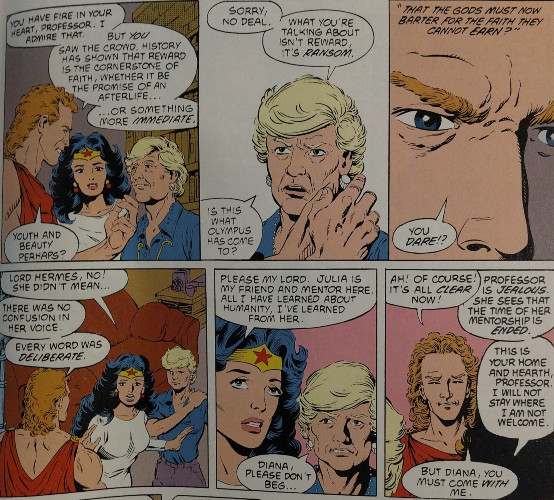
The Amazons are not without their pain points regarding strangers, men in particular–Perez used Greek mythology well in the first volume to adequately showcase the Themyscirans' distrust of humanity–but this annual and subsequent issues offer the potential for healing, of new life, all because Diana has seen for herself the complexities of regular, ordinary humans, the good and bad woven together like a quilt. She has come to understand the striations within humanity and helps her sister Amazons to see that, maybe, being cut off from the outside world completely is a backward way of living. Progress will not be without pain or sacrifice, but Diana believes growth is possible, if all sides are open to the possibility. A Cold War-era undertone flits through the dialogue and across the panels, a subtle reminder to readers that unity is difficult and that some scars may never heal but remains an ideal worth striving for.
Yet the world provides its own challenges for Wonder Woman, and Perez (and to a lesser extent, Wein) shows the darker side of existence to balance out the positives. A celebration thrown in Diana's honor causes concern over her status as a popular symbol, especially when a crooked industrialist sics a supervillain on her. People, particularly men, often initially objectify Diana, her physical beauty affecting their first impressions. A powerful issue deals with the murder of a supporting cast member, with Diana tearing through the Boston underworld to locate the killer. Darkness looms over the pages, and with it, a sense of tension on both the side of humanity and the side of superhumanity. Diana may be a "wonder" to people–a legend to idolize, a spectacle to behold, a hero to admire (even if that admiration is sometimes twisted)–but she is also a "woman," with human reactions and emotions. "Even a god can be all too human," Julia tells Diana when an Olympian sheds tears, and if the gods themselves can express signs of humanity, why should we expect anything less from a human representing the intersection of the mundane and the divine?
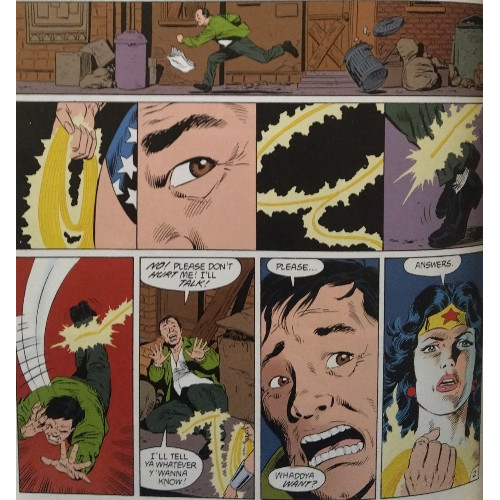
That "powerful issue" I just referenced is the volume's high water mark, the best bit of writing from Perez. It's a standalone issue, with reprecussions flowing outward, but it so well encapsulates what Perez is doing correctly with Wonder Woman. As I noted, a distraught Diana uses her strength and lasso to tear through Boston; she is a hero on a rampage, seeking answers–nay, demanding answers. Meanwhile, cops and detectives interview suspects and close associates of the victim, piecing together the all-too-human vendettas and hatreds which would bring a person to consider murder and then act upon that urge. The final page yanks the rug from beneath the cast and the reader, providing a well-written twist on the murder which shoves the blade a little deeper into Wonder Woman and the audience. "Detective yarn" may better fit a guy like Batman, but Perez creates a genuinely compelling issue which shows Diana at her most determined, her own anger pushing her pursuit to avenge a deep injustice.
If any narrative bullets slip past this volume's bracelets, it's in some of the subplotting Perez inputs. Diana is, at points, shown to be smitten with Superman, an idea which could be played out interestingly if Perez had fully controlled that particular narrative. But he doesn't, for some reason, and the bulk of the story played out elsewhere, leaving us with some strange scenes where Diana pines for the Man of Steel without us witnessing any dramatic resolution to the whole bit. Other subplots feel like they are still ongoing by the time this volume wraps, yet a few are introduced awkwardly. A few supporting cast members are suddenly revealed to be involved in what I assume is a larger plot, with their sudden shift to background status feeling abrupt. You get the sense Perez has a few irons in the fire, but he's a tad too subtle for his own good. It could be that further exploration of the series is needed to fully understand some of these irons, and if that's the case, I may someday recant this statement. But, for now, I feel the subplotting is somewhat sloppy.
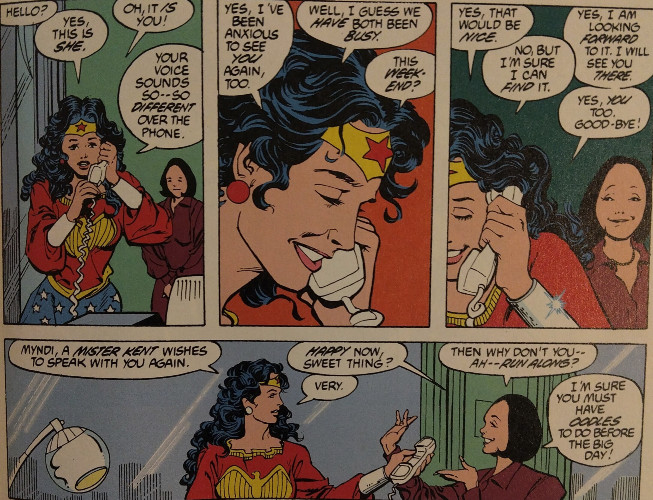
Aside from this minor complaint, I have high praise for Perez's vision for Wonder Woman, like a trumpeter heralding the arrival of a Greek deity. He handles Diana's character well, finding in her the compelling concept that she represents two worlds. Like Superman lives at the crossroads of Krypton and Kansas, Diana exists at the intersection of mortal and immortal. She is to be a blessing to "patriarch's world," bringing lofty ideals to a divided place filled with tension, yet she also symbolizes the tempered powers and passions of the gods. If the gods experience a level of humanity, as Julia attests, then Diana represents the ability to relate to mankind in a way they don't allow themselves to. She's not too high above people to expect worship or adulation, and she knows hurt, anger, even love in a way the gods do not…or even her fellow Amazons, sequestered on Paradise Island. I don't know how Perez tapped into these concepts across further issues, but if I have the chance to continue exploring Diana's adventures, I hope to see these ideas play out across the years.